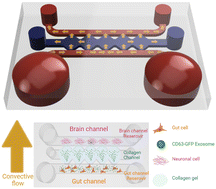The gut communicates with the brain in a variety of ways known as the gut–brain axis (GBA), which is known to affect neurophysiological functions as well as neuronal disorders. Exosomes capable of passing through the blood–brain-barrier (BBB) have received attention as a mediator of gut–brain signaling and drug delivery vehicles. In conventional well plate-based experiments, it is difficult to observe the exosome movement in real time. Here, we developed a microfluidic-based GBA chip for co-culturing gut epithelial cells and neuronal cells and simultaneously observing exosome transport. The GBA-chip is aimed to mimic the in vivo situation of convective flow in blood vessels and convective and diffusive transport in the tissue interstitium. Here, fluorescence-labeled exosome was produced by transfection of HEK-293T cells with CD63-GFP plasmid. We observed in real time the secretion of CD63-GFP-exosomes by the transfected HEK-293T cells in the chip, and transport of the exosomes to neuronal cells and analyzed the dynamics of GFP-exosome movement. Our model is expected to enhance understanding of the roles of exosome in GBA.
